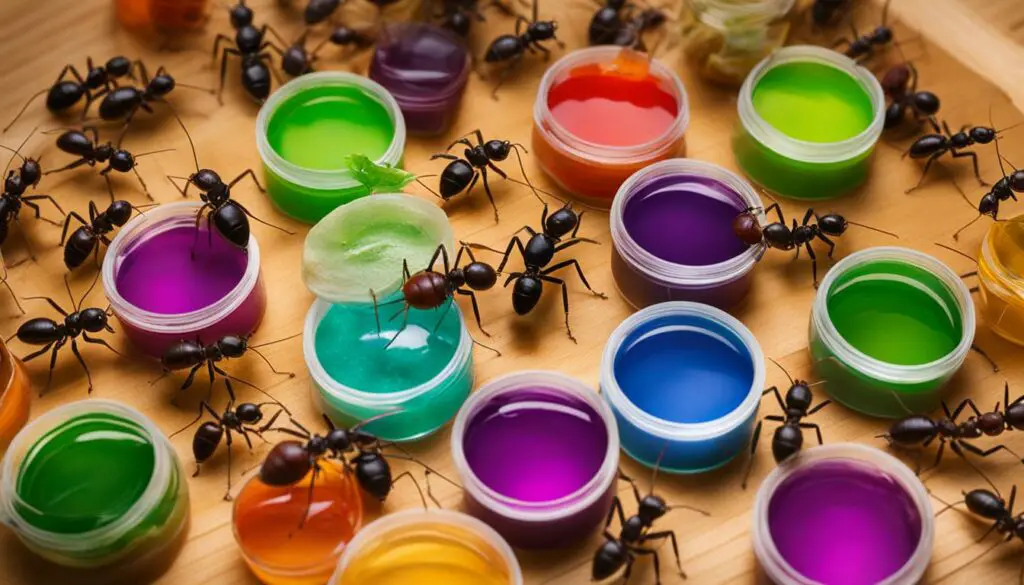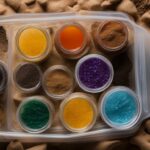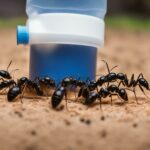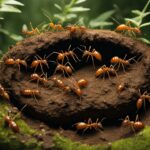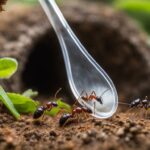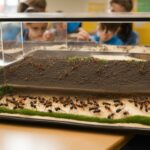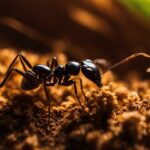Gel ant farms have become increasingly popular among ant keepers, offering a unique way to observe and study these fascinating creatures. However, when it comes to the long-term health and well-being of your ants, nutrition is key. That’s where ant nutrition gel food comes in. This specially formulated gel provides essential nutrients, supports colony growth, and helps maintain a thriving ant farm.
Ant nutrition gel food offers numerous advantages over traditional feeding methods. Its unique gel texture allows ants to easily access and consume the nutrients, ensuring they receive a well-balanced diet. With a variety of beneficial ingredients, this gel food provides the nourishment ants need for optimal health and vitality.
Whether you’re a seasoned ant keeper or just starting out, ant nutrition gel food is a must-have addition to your ant-keeping arsenal. Let’s dive deeper into the benefits of ant nutrition gel food and explore why it’s the ideal choice for enhancing the vitality of your ant colony.
Key Takeaways:
- Ant nutrition gel food provides essential nutrients and supports colony growth.
- Its unique gel texture allows ants to easily access and consume the nutrients.
- Ant nutrition gel food is specially formulated to meet the dietary needs of ants.
- Using ant nutrition gel food can help maintain a thriving ant farm.
- It is a convenient and effective way to enhance the vitality of your ant colony.
Understanding the Difference between Ant Farms and Formicaria
Ant farms and formicaria are two distinct types of habitats designed for keeping ants, each serving a different purpose. It is essential to understand the differences between these two setups to ensure the best care for your ant colony.
An ant farm is a small enclosed container primarily used for temporary observation and educational purposes. It provides a simple and convenient way to observe ants in action, allowing individuals to learn about their behavior and social structure. However, ant farms are not suitable for long-term ant keeping as they lack the necessary features for colony growth and sustainability.
| Ant Farms | Formicaria |
|---|---|
| Designed for temporary observation | Designed for long-term ant keeping and colony growth |
| Simple enclosure with limited features | Complex setup mimicking natural ant habitats |
| Not suitable for sustained colony growth | Provides chambers, tunnels, and nesting areas for long-term sustainability |
| Easy to set up and maintain | Requires careful planning and maintenance |
Formicaria, on the other hand, are specialized habitats that mimic the ants’ natural environment. They are designed to provide chambers, tunnels, and nesting areas that support the long-term growth and sustainability of ant colonies. Formicaria require careful planning and maintenance to ensure optimal conditions for the ants’ well-being.
When choosing between an ant farm and a formicarium, it is important to consider the specific needs of your ants. If you are looking for a temporary observation setup, an ant farm may be suitable. However, if you are committed to long-term ant keeping and colony growth, investing in a well-designed formicarium is the recommended choice.
Why Gel Ant Farms are Unsafe for Ants
Gel ant farms have gained popularity as fascinating habitats for observing ants in action. However, these seemingly innovative setups pose serious safety concerns for the ants themselves. The gel material used in these farms does not provide the necessary environment and moisture levels for ants to thrive. As a result, ants can face nutritional deficiencies, unsanitary living conditions, and even become trapped in the gel, leading to harm and potential death.
The gel material used in ant farms does not offer the essential nutrition that ants require for their well-being. Ants need a varied diet consisting of sugars, proteins, and fats to maintain their health and energy levels. Unfortunately, the gel in ant farms lacks these vital nutrients, leading to nutritional deficiencies that can ultimately result in starvation or malnutrition for the ants.
Furthermore, the gel material in ant farms can quickly become contaminated, resulting in unsanitary living conditions for the ants. The moisture in the gel creates an ideal environment for the growth of bacteria and mold, posing additional health risks to the ants. These conditions can further exacerbate the nutritional deficiencies and overall well-being of the ants, significantly reducing their lifespan and colony growth potential.
Overall, while gel ant farms may seem like a visually appealing and convenient option for observing ants, they are not safe or suitable for the long-term well-being of the ants. It is crucial to consider alternatives, such as sand or loam-based habitats, that provide a more natural and nourishing environment for ants to thrive.
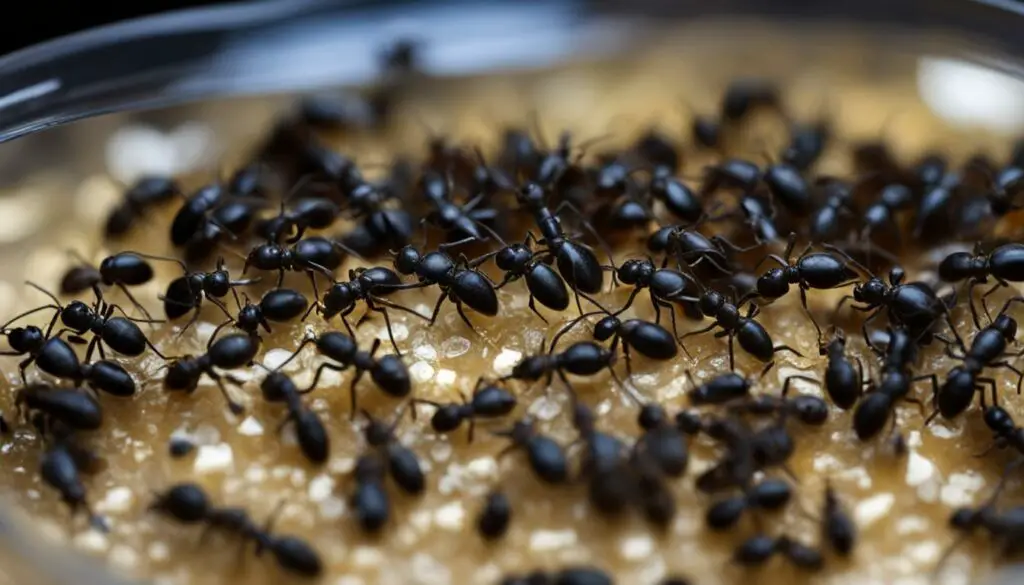
Table: Safety Concerns and Risks in Gel Ant Farms
| Safety Concerns | Risks |
|---|---|
| Nutritional Deficiencies | Ants may experience malnutrition and starvation due to the lack of essential nutrients in the gel. |
| Unsanitary Conditions | The gel material can become contaminated, leading to the growth of bacteria and mold, posing health risks for the ants. |
| Trapped Ants | The gel can trap and suffocate ants, causing harm and potential death. |
The Pitfalls of Gel Ant Farm Ingredients
Gel ant farms, a popular choice among ant enthusiasts, are primarily made of agar, a substance commonly used in microbiology for growing bacteria and other microorganisms. While agar provides a gel-like texture and serves as a medium for ants to tunnel and explore, the ingredients used in gel ant farms can pose some limitations and potential risks for ant health and well-being.
Additives such as coloring agents, sugar, and fungicides are often included in gel ant farms to provide some nutrients and prevent mold growth. However, these ingredients do not offer a complete and balanced diet for ants. Ants require a more varied diet consisting of sugars, proteins, and fats to meet their nutritional needs.
“The gel’s nutritional limitations can further contribute to the unsuitability of gel ant farms for long-term ant keeping.”
While gel ant farms may initially seem convenient and visually appealing, it is important to consider the nutritional limitations of the gel material. Providing ants with a diet solely based on gel ant farm ingredients can lead to nutritional deficiencies, which can negatively impact their health and overall well-being.
| Gel Ant Farm Ingredients | Nutritional Limitations |
|---|---|
| Agar | Does not provide a complete and balanced diet |
| Additives (coloring agents, sugar, fungicides) | Insufficient in meeting ants’ nutritional needs |
While observing ants in a gel ant farm can be fascinating, it is crucial to prioritize their health and well-being by providing them with a suitable and nutritionally balanced environment. Consider alternative ant habitats that offer a varied diet and meet the nutritional requirements of ants for long-term ant keeping.
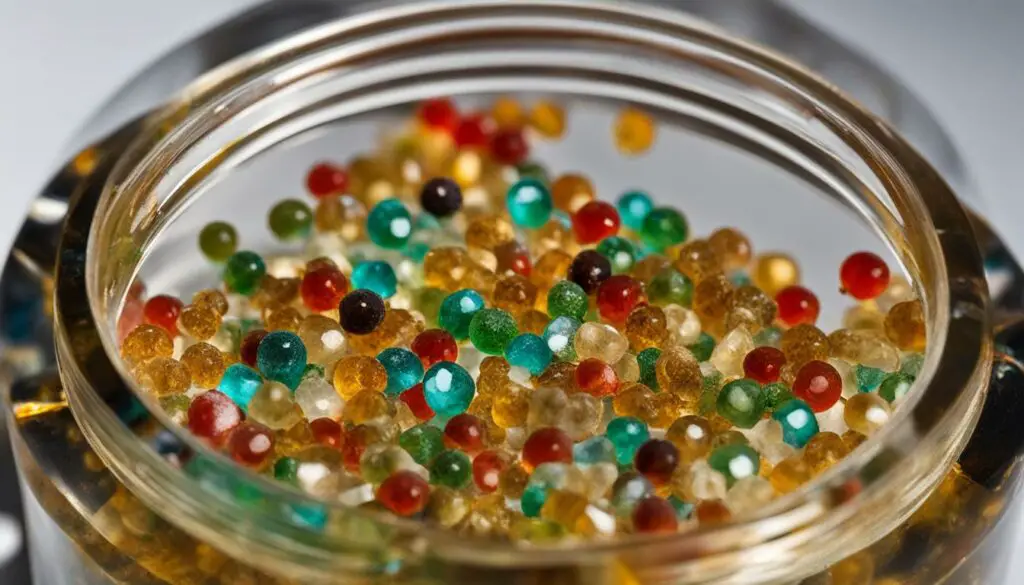
Making Gel Ant Farms Safe for Ants
Gel ant farms can be made safe for ants by taking certain precautions and modifying the habitat. The first step is to completely remove the gel and replace it with a sand or loam mixture. This provides a more natural environment for the ants and allows them to exhibit their natural behaviors, such as tunneling and nest-building.
It is essential to provide a suitable source of moisture for the ants within the habitat. This can be done by adding a small water dispenser or a moistened cotton ball. This ensures that the ants have access to the necessary hydration they need to thrive. Additionally, it is crucial to provide proper food sources for the ants. Ants require a varied diet consisting of sugars, proteins, and fats. You can achieve this by placing small pieces of fruit, sugar water, and protein-rich food like crushed insects or fish flakes within the habitat.
Proper ventilation and cleanliness are also important factors in making gel ant farms safe for ants. This helps prevent the buildup of harmful substances and ensures a healthy living environment for the ants. Regularly cleaning the habitat and removing any uneaten food or waste will help maintain cleanliness and prevent the growth of mold or bacteria.
Example Table: Comparing Gel Ant Farms and Sand Ant Farms
| Gel Ant Farms | Sand Ant Farms | |
|---|---|---|
| Nutritional Suitability | Not suitable for long-term ant keeping due to nutritional limitations | Can provide a more natural and varied diet for ants |
| Moisture Control | Gel material can become unsanitary and lack sufficient moisture | Proper moisture levels can be maintained with a suitable substrate |
| Behavioral Expression | Does not allow for natural behaviors like tunneling and nest-building | Allows ants to exhibit their natural behaviors and create tunnels and nests |
| Long-term Sustainability | Not ideal for long-term ant keeping due to safety concerns | Can provide a safer and more sustainable habitat for ants |
Despite efforts to make gel ant farms safe, it is important to note that they are still not ideal for long-term ant keeping. Sand ant farms, with their natural substrate and ability to provide a more suitable environment, are a safer alternative for creating a thriving ant colony. By following the recommended steps and providing the necessary moisture and food sources, you can ensure the well-being of your ants and enjoy the fascinating world of ant keeping.
The Purpose and Development of Gel Ant Farms
Gel ant farms have a fascinating history rooted in scientific research and experimentation. They were initially developed by NASA as a unique tool for studying ant behavior in a controlled and self-contained environment. The gel material used in these ant farms served not only as a medium for tunnelling but also as a source of nutrition for the ants. The three-dimensional tunnel architecture created by the ants in the gel provided valuable insights into their behavior and adaptation to microgravity conditions.

Through the NASA Space Shuttle experiment conducted in 2003, scientists were able to observe how ants tunnel in microgravity and study animal life in space. This research aimed to gain a better understanding of the effects of microgravity on animal behavior and how ants could adapt to such conditions. Gel ant farms provided a controlled and replicable environment for these studies, offering a unique perspective on ant behavior that would have been challenging to achieve in traditional ant habitats.
While the development of gel ant farms for scientific purposes has been successful, questions have arisen regarding their suitability for long-term ant keeping. Safety concerns, such as unsanitary living conditions and nutritional deficiencies, have been highlighted. As a result, there has been a growing interest in exploring safer alternatives, such as sand ant farms, that can provide a more suitable and sustainable living environment for ants.
Understanding the Safety of Sand Ant Farms
When it comes to keeping ants in a safe and suitable environment, sand ant farms can be a viable option. However, it is important to be aware of the potential risks and take necessary precautions to ensure the well-being of your ant colony.
One of the main risks associated with sand ant farms is the substrate considerations. Sand used as a substrate can become too dry, making it difficult for ants to tunnel and build nests. This can lead to compaction issues and the risk of chamber collapses. To mitigate these risks, it is recommended to substitute pure sand with a high-quality substrate that contains a mixture of sand, silt, and clay. This provides a more stable and structurally sound environment for the ants to thrive in.
“Sand ant farms can be a safe and suitable option for ant keeping when set up correctly and maintained properly.”
Hydration mechanisms also play a crucial role in the safety of sand ant farms. Proper moisture levels should be maintained to prevent the sand from becoming too dry or too moist. This can be achieved by using a water dispenser or a moistened cotton ball within the habitat. Regular monitoring of moisture levels and adjustments as needed are essential to prevent sand erosion and tunnel collapses.
Another risk to consider is the potential for mold or bacterial growth in the sand. This can occur if the sand becomes too moist or if food or waste is left in the substrate for too long. To prevent this, it is important to maintain cleanliness by regularly cleaning the sand ant farm and removing any food or waste debris. Choosing a high-quality substrate that is less prone to mold growth can also help mitigate this risk.
Table: Comparing Safety Considerations of Gel Ant Farms and Sand Ant Farms
| Gel Ant Farms | Sand Ant Farms | |
|---|---|---|
| Substrate | Gel material | High-quality sand, silt, and clay mixture |
| Moisture Control | Gel material retains moisture | Regular monitoring and adjustment of moisture levels |
| Risk of Collapses | Minimal risk | Potential for compaction and collapses |
| Mold/Bacterial Growth | Potential for contamination | Regular cleaning and removal of debris |
While sand ant farms can be a safe and suitable option for ant keeping when set up correctly and maintained properly, it is important to be aware of the risks and take necessary precautions. By considering substrate considerations, maintaining proper hydration mechanisms, and preventing mold growth, you can create a safe and thriving habitat for your ant colony.
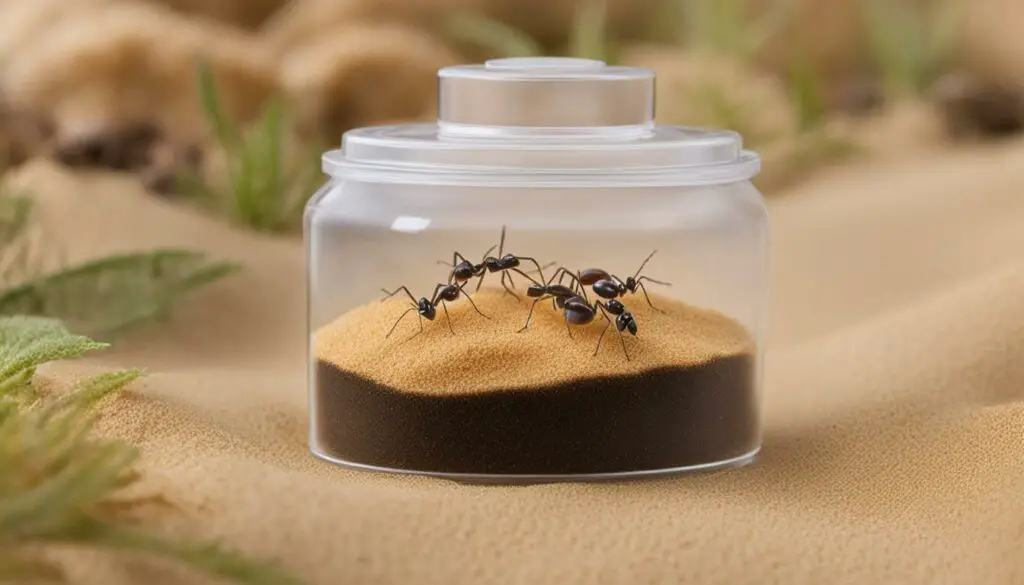
Making Sand Habitats Safe for Ants
When setting up a sand ant farm, it is important to take certain measures to ensure the safety and well-being of your ants. By following these guidelines, you can create a suitable environment that promotes their overall health and longevity.
Substituting Pure Sand with High-Quality Substrates
Instead of using pure sand in your ant farm, consider using a high-quality substrate that contains a mixture of sand, silt, and clay. This soil mixture provides a more stable and supportive habitat for ants to tunnel and build nests. You can also enhance the structural integrity of the substrate by adding perlite or vermiculite.
Maintaining Moisture Levels
Proper moisture levels are crucial for ants living in a sand habitat. To maintain optimal hydration, consider using a small water dispenser or moistened cotton ball in the ant farm. This ensures that ants have access to the necessary moisture for survival and nest building.
Preventing Mold Growth
Mold can be a common issue in sand ant farms if proper precautions are not taken. To prevent mold growth, it is important to maintain cleanliness. Regularly remove any leftover food or waste from the substrate and clean the ant farm to minimize the risk of mold development. Additionally, ensuring proper ventilation within the habitat can help prevent excessive moisture buildup and reduce the chances of mold growth.
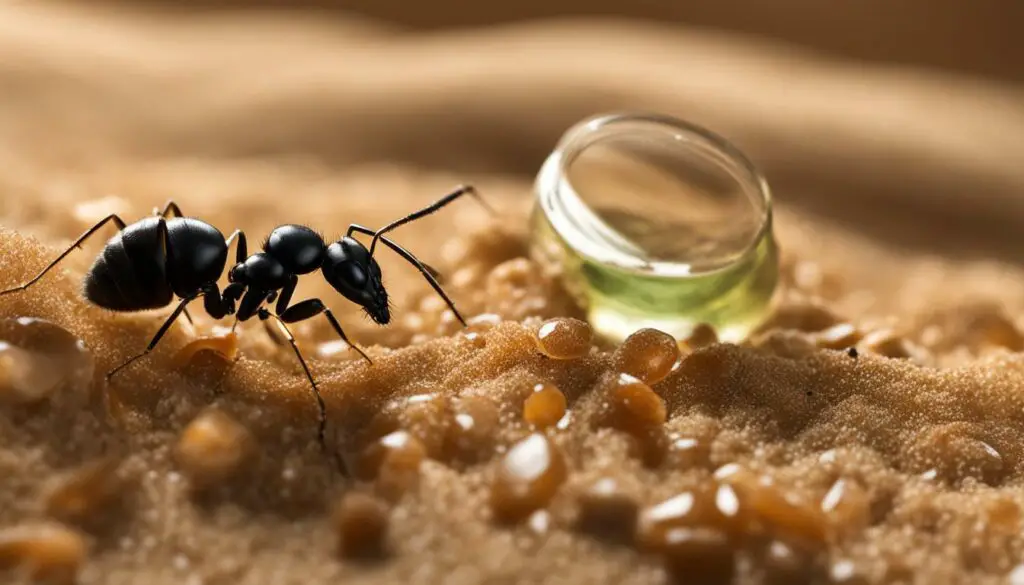
| Considerations for Safe Sand Ant Farms | Methods |
|---|---|
| Substituting pure sand | Use high-quality substrates with sand, silt, and clay mixtures |
| Maintaining moisture levels | Use a water dispenser or moistened cotton ball |
| Preventing mold growth | Clean the ant farm regularly, ensure proper ventilation |
The Importance of Edible Insects for Sustainable Protein Sources
Edible insects are emerging as a valuable and sustainable alternative protein source in the quest for a more environmentally friendly food system. With the increasing global demand for meat and the detrimental environmental impact of traditional livestock farming, exploring alternative sources of protein has become crucial.
When it comes to sustainability, edible insects have a clear advantage. They require significantly less land, water, and energy compared to conventional meat production. Insects also have a high feed conversion rate, meaning they can convert their food into body mass more efficiently than traditional livestock.
Furthermore, edible insects are packed with essential nutrients. They are rich in high-quality proteins, essential amino acids, minerals, and vitamins. Incorporating insects into our diets can help address protein deficiencies and improve overall nutrition intake.
“Insects offer a sustainable and nutritious solution for meeting the growing demand for protein in a world facing environmental challenges.”
The Future of Edible Insects
The future of edible insects looks promising. As research and development in this field continue to expand, we can expect to see innovative insect-based food products hitting the market. These products will not only provide a sustainable protein source but also promote healthier and more environmentally friendly food choices.
However, it is important to address consumer perception and overcome any aversion to insect consumption. Education and awareness about the nutritional and environmental benefits of incorporating insects into our diets are key to fostering a positive attitude towards this sustainable protein source.
As we strive for a more sustainable and resilient food system, edible insects have the potential to play a significant role in meeting global protein needs while minimizing the impact on our planet.
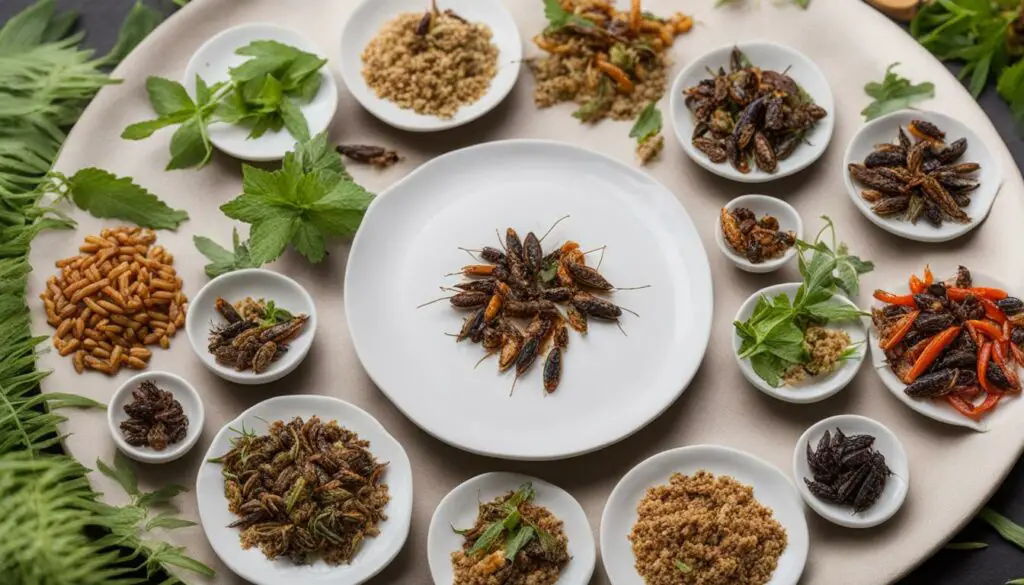
| Nutritional Content of Edible Insects | Protein (g/100g) | Fat (g/100g) | Iron (mg/100g) | Calcium (mg/100g) | Vitamin B12 (µg/100g) |
|---|---|---|---|---|---|
| Crickets | 21.2 | 6.5 | 9.5 | 75.8 | 0.13 |
| Mealworms | 20.1 | 13.2 | 1.06 | 62 | 1.20 |
| Black Soldier Fly Larvae | 20.5 | 13.8 | 3.6 | 46 | 2.17 |
Insects in Food Products for Enhanced Nutrition
In recent years, there has been a growing interest in incorporating insects into food products to enhance their nutritional content. Cereal-based foods, in particular, have been enriched with insect flour, providing an additional source of protein and essential nutrients. By harnessing the sustainable and nutrient-rich properties of insects, these innovative food products offer a compelling and environmentally friendly solution to address protein deficiencies and promote a more sustainable food system.
One of the key advantages of using insect flour in cereal-based foods is its high protein content. Insects such as crickets, grasshoppers, and mealworms are rich in essential amino acids, minerals, and vitamins, making them a valuable source of nutrients. Incorporating insect flour into staple foods like bread and tortillas not only increases their protein levels but also improves their overall nutritional profiles.
| Benefits of Incorporating Insects in Food Products |
|---|
| Enhanced nutritional content through increased protein levels |
| Sustainable and environmentally friendly protein source |
| Diversification of food options for individuals with dietary restrictions |
| Promotion of sustainable food choices and reduction of environmental impact |
While the concept of using insects in food products may initially seem unconventional, it presents a practical solution to address the need for sustainable protein sources. Insects have a significantly lower environmental impact compared to traditional livestock farming, requiring less land, water, and energy. Additionally, incorporating insect-based food options can diversify food choices, particularly for individuals with dietary restrictions.
As consumer awareness of the benefits of insect consumption grows, the market for insect-based food products continues to expand. Culinary innovation has played a crucial role in creating insect-enhanced snacks, ranging from extruded snacks like chips and crackers to protein bars made with cricket flour. These products not only contribute to improved nutrition but also promote sustainable food choices and reduce the environmental impact associated with traditional snack production.

Conclusion
The incorporation of insects in food products presents a promising avenue to enhance nutrition and promote sustainability. By enriching cereal-based foods with insect flour, it is possible to increase protein levels and improve the overall nutritional profile. This innovative approach offers a sustainable protein source, diversifies food options, and reduces the environmental impact of traditional food production. As the demand for sustainable and alternative protein sources continues to rise, insect-based food products have the potential to play a significant role in shaping a more sustainable and environmentally friendly future.
Insect-Enhanced Snacks for Health and Sustainability
When it comes to snacks, there is a new trend on the rise – insect-enhanced options. These culinary innovations offer both health benefits and sustainability, making them a unique and intriguing choice for those looking to make more conscious food choices. Insect-enhanced snacks can take various forms, including extruded snacks like chips and crackers, as well as protein bars made with cricket flour.
What makes these snacks so special is the inclusion of insect flour, which provides an additional source of protein and essential nutrients. Insects are highly nutritious, packed with high-quality proteins, vitamins, and minerals. They are also a sustainable protein source, requiring fewer resources such as land, water, and energy compared to traditional livestock farming.
By incorporating insect-enhanced snacks into our diet, we can enjoy the health benefits of increased protein intake while also contributing to a more sustainable food system. These snacks not only offer a convenient and tasty option but also help reduce the environmental impact associated with traditional snack production. So, why not give insect-enhanced snacks a try and join the culinary innovation that is shaping the future of food?
Benefits of Insect-Enhanced Snacks:
- Increased protein intake: Insect flour adds a significant amount of protein to snacks, enhancing their nutritional value.
- Sustainable choice: Insects require fewer resources to produce compared to traditional livestock, making them a more environmentally friendly protein source.
- Diverse nutrient profile: Insects are rich in essential amino acids, vitamins, and minerals, offering a well-rounded nutritional profile.
- Culinary innovation: Insect-enhanced snacks push the boundaries of traditional snack production, introducing unique and exciting flavors to the market.
Example of Insect-Enhanced Snacks:
| Snack Type | Product | Key Ingredients | Benefits |
|---|---|---|---|
| Extruded Snacks | Insect-Infused Tortilla Chips | Corn, insect flour, seasoning | High protein content, sustainable choice |
| Protein Bars | Cricketer’s Delight Protein Bar | Crickets, nuts, dried fruits | Complete protein source, convenient snack |
| Crackers | Insect Crunch Crackers | Wheat flour, insect flour, herbs | Unique texture, sustainable ingredients |
As we explore new ways to nourish ourselves and protect the planet, insect-enhanced snacks offer a compelling solution. With their nutritional benefits, sustainability, and innovative flavors, these snacks are not only good for us but also for the environment. So, embrace culinary innovation and try some insect-enhanced snacks for a healthier, more sustainable snacking experience.
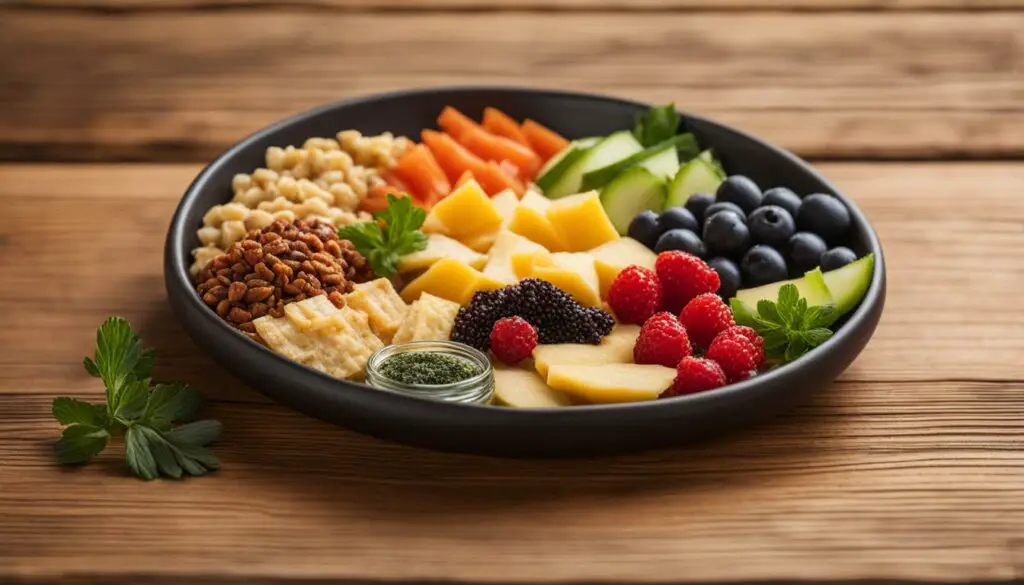
“Insect-enhanced snacks provide a unique opportunity to incorporate sustainable protein sources into the daily diet, offering a healthier and more environmentally friendly snacking alternative.” – [Your Name]
Safety and Regulations of Insect Consumption as Food
When considering the safety of consuming insects as food, it is important to address microbiological considerations, adhere to regulations, and understand consumer perception. Microbiological safety is paramount to eliminate the risk of foodborne illnesses. Proper handling, processing, and storage practices must be followed to ensure that insects intended for consumption are free from harmful bacteria and pathogens.
Governing bodies in different countries are implementing regulations for insect consumption to guarantee consumer safety. These regulations cover aspects such as insect sourcing, processing methods, labeling requirements, and hygiene standards. By adhering to these regulations, food producers ensure that insect-based products meet the necessary quality and safety standards.
Consumer perception also plays a significant role in the acceptance and adoption of insect-based food products. While insects have been consumed as food in various cultures throughout history, they are still relatively novel to many consumers. Educating the public about the nutritional and environmental benefits of insect consumption can help alleviate any concerns and foster greater acceptance of this sustainable protein source.
Table: Regulations for Insect Consumption in Selected Countries
| Country | Regulatory Body | Main Regulations |
|---|---|---|
| United States | Food and Drug Administration (FDA) | Novel Food Approval Process, Good Manufacturing Practices (GMP) |
| European Union | European Food Safety Authority (EFSA) | Novel Food Regulation, Hygiene Regulations |
| Canada | Canadian Food Inspection Agency (CFIA) | Novel Foods Regulations, Safe Food for Canadians Regulations |
| Australia | Food Standards Australia New Zealand (FSANZ) | Food Standards (Insects as Food) Variation, Food Safety Standards |
| Japan | Ministry of Health, Labour and Welfare (MHLW) | Food Sanitation Act, Food Labeling Act |
By prioritizing microbiological safety, adhering to regulations, and addressing consumer perception, the safety and acceptance of insect consumption as food can be ensured. This paves the way for the integration of insects as a sustainable protein source in the global food system, contributing to a more environmentally friendly and nutritionally diverse future.
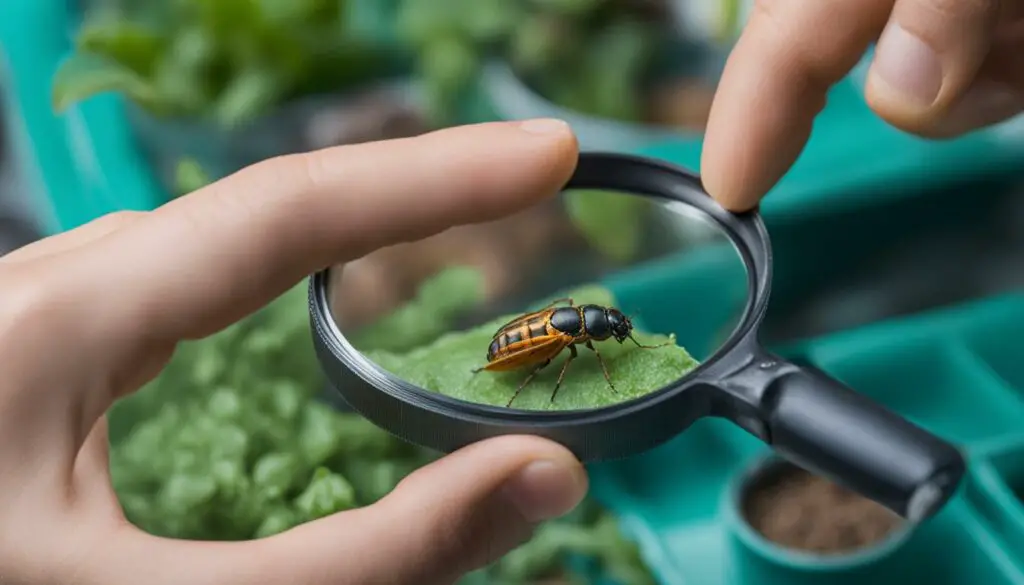
The Future of Insect-Based Protein Sources
As the demand for sustainable protein sources continues to grow, the future of insect-based protein sources looks promising. Edible insects offer a viable solution to the environmental concerns associated with traditional meat production while providing a nutritious alternative. With their high-quality proteins, essential amino acids, minerals, and vitamins, insects can help address protein deficiencies and enhance the overall nutrition intake of populations worldwide.
Furthermore, the market trends indicate a rising interest in insect-based food products. Consumers are becoming more conscious of the environmental impact of their food choices and are actively seeking sustainable options. Insect-enhanced snacks, such as protein bars and extruded snacks enriched with insect flour, offer a convenient and eco-friendly alternative to traditional snacks. They not only contribute to improved nutrition but also promote a more sustainable food system.
| Insect-Based Protein Sources | Benefits |
|---|---|
| Edible Insects | – High-quality proteins and essential amino acids |
| Insect-Enhanced Snacks | – Convenient and sustainable snack options |
| Insect-Enriched Foods | – Enhanced nutrition profiles in staple food products |
Research and development efforts are focused on optimizing production methods, creating innovative food formulations, and addressing consumer concerns regarding insect consumption. The integration of insect-based protein sources into the food industry is a step towards meeting global protein needs while reducing the environmental impact of traditional meat production. As awareness and acceptance of insect-based foods continue to grow, the future holds great potential for insects to play a significant role in our sustainable and environmentally friendly food system.
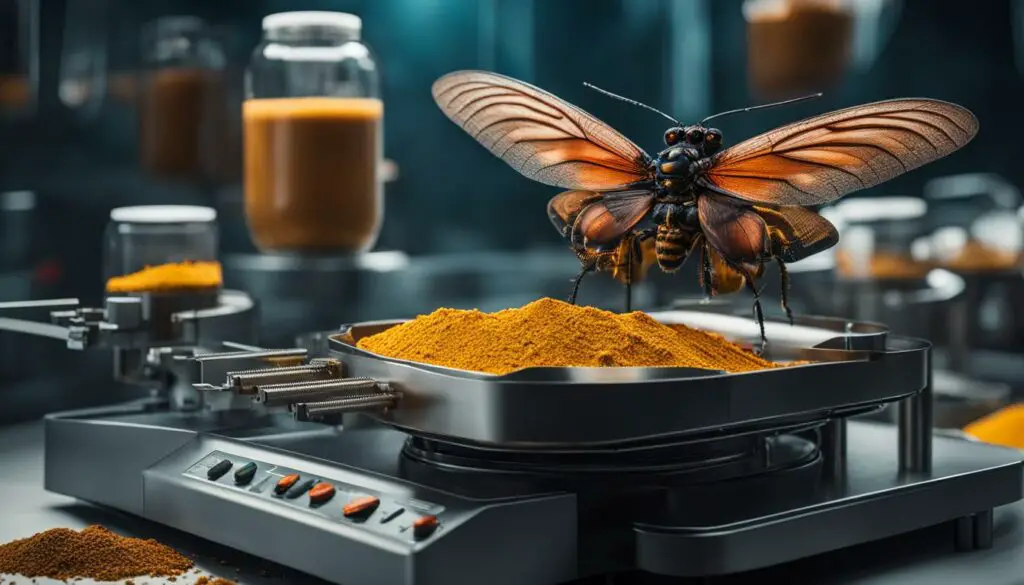
Conclusion
As an ant enthusiast and advocate for safe and sustainable ant keeping, I highly recommend incorporating ant nutrition gel food into your colony’s diet. The benefits of this specialized gel food are truly remarkable. It provides essential nutrients that support the health and growth of your ants, ensuring the overall well-being of your ant farm.
While gel ant farms may seem fascinating, it’s important to prioritize the safety of your ants. Gel ant farms can pose significant risks to the long-term health of ants due to unsanitary conditions, nutritional deficiencies, and the potential for ants to become trapped. Instead, opt for sand ant farms, which offer a safer and more suitable environment for your ant colony.
Furthermore, the incorporation of insects as sustainable protein sources is an exciting and environmentally friendly solution. Insects, including ants, are rich in essential nutrients and have a significantly lower environmental impact compared to traditional livestock farming. By practicing responsible ant keeping and exploring insect-based food options, we can contribute to a more sustainable future that addresses global nutrition needs.
So let’s continue to nourish our ants with ant nutrition gel food, prioritize their safety by choosing suitable habitats, and support the development and utilization of sustainable protein sources. Together, we can make a positive impact on the well-being of our ants and the planet.
FAQ
What are the benefits of Ant Nutrition Gel Food?
Ant Nutrition Gel Food provides essential nutrients, supports colony growth, and helps maintain a thriving ant farm.
What is the difference between Ant Farms and Formicaria?
An ant farm is a small enclosed container designed for temporary observation, while a formicarium is a more complex and permanent habitat for long-term colony growth.
Why are Gel Ant Farms unsafe for ants?
Gel Ant Farms can quickly become contaminated, leading to unsanitary living conditions and potential harm to the ants. The gel also does not provide sufficient nutrition and can trap and suffocate ants.
What are the pitfalls of Gel Ant Farm ingredients?
Gel Ant Farms primarily use agar as a tunnelling medium, but it does not offer a complete and balanced diet for ants. Additives like coloring agents and fungicides also do not provide sufficient nutrition.
How can Gel Ant Farms be made safe for ants?
Gel Ant Farms can be made safe by removing the gel and replacing it with a sand or loam mixture. Moisture and food sources should also be provided within the habitat.
What is the purpose and development of Gel Ant Farms?
Gel Ant Farms were initially developed by NASA for studying ant behavior in a unique, self-contained environment. The gel material served as a tunnelling medium and nutrient source for observing tunnel architecture.
Are Sand Ant Farms safe for ants?
Sand Ant Farms can be safe if properly set up and maintained, but they come with risks such as dryness, compaction issues, and potential mold or bacterial growth.
How can safety be ensured in Sand Ant Farm setups?
To make sand ant farms safe, it is important to use a high-quality substrate, maintain proper moisture levels, and prevent mold growth through regular cleaning.
What is the importance of edible insects for sustainable protein sources?
Edible insects offer high-quality proteins, essential amino acids, minerals, and vitamins while requiring less land, water, and energy compared to traditional livestock farming.
How can insects be incorporated into food products for enhanced nutrition?
Insects can be used to enrich cereal-based foods like bread and tortillas by adding insect flour, increasing protein levels and improving overall nutritional profiles.
What are insect-enhanced snacks and their benefits?
Insect-enhanced snacks, such as chips, crackers, and protein bars made with insect flour, offer additional sources of protein and essential nutrients, promoting both health benefits and sustainability.
What safety and regulations are in place for insect consumption as food?
Microbiological safety measures, regulations, and consumer education are important to ensure the safe consumption of insects as food and address any concerns about foodborne illnesses.
What does the future hold for insect-based protein sources?
The future of insect-based protein sources looks promising, with ongoing research and development focused on optimizing production methods, creating innovative food products, and addressing consumer concerns about sustainability and safety.
What are the benefits of Ant Nutrition Gel Food and the importance of safe ant keeping?
Ant Nutrition Gel Food offers numerous benefits for ant health and colony growth. By practicing responsible ant keeping and understanding the limitations of gel ant farms, individuals can contribute to a more sustainable and environmentally friendly future.

